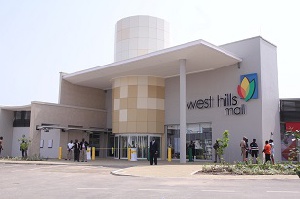The attention of the Management of West Hills Mall has been drawn to a comment in the media (purported to have been made by the Honourable MP for the Weija-Gbawe Constituency, Madam Tina Naa Ayeley Mensah), suggesting that the incidence of flooding in parts of her constituency is the result of the construction of West Hills Mall.
Although the claim is spurious and was obviously made without reference to the topography and flood history of the area, we feel obliged to react to correct the erroneous impression the Honourable MP’s comments might have created among uninformed members of the public.
The point must be made in no uncertain terms, that the Old Barrier/Atala stretch of the Accra- Winneba highway (which lies more than one kilometre away from Dunkonah where West Hills Mall is located) is a low-lying platform and has for many years always suffered flooding. Early residents of the area would confirm that as far back as in the 1990s’ and even before the string of private developments, including ATALA, sprung up along the route, this stretch had been prone to flooding. As always, the degree of flooding depended on the intensity and duration of the rains.
In 2009/10, when the idea of building a shopping mall was conceived, the Developers took account of two key issues which had to be addressed as integral aspects of the project design: One was to ensure that the flow of traffic to the mall was independent of the run of traffic on the Accra Winneba highway and that driving into and out of the mall did not impose any conflict or interruptions to traffic flow on the highway. A thorough traffic impact assessment (TIA) was conducted by a joint team of experts comprising the Developer and the Ghana Highway Authority, resulting in the commitment of an enormous amount of resources and engineering to build what is now the West Hills Mall Interchange.
This reference becomes relevant here because immediately the mall was completed, certain individuals who commuted to Kasoa and beyond on a daily basis, frantically sought to blame the near proverbial rush-hour traffic generated by the Weija Toll Booth along the Kasoa road, on the construction of the mall.
The other issue of concern to the Developer was drainage, being fully aware of what happens whenever there is a heavy downpour one kilometre away on the Accra-bound track of the highway. The topography of the Dunkonah area was critically studied. The area, as residents may remember, experienced minimum flooding, but the Developer took no chances; two existing drains (one at the SCC traffic light and the other behind the building which now houses Melcom) were expanded and a new Storm Drain built to contain all run-off rainwater from the entire mall area. This storm drain is connected to the already existing drain behind the Melcom Building and to the relief of residents, has, since 2014, changed the story of flooding in that part of Dunkonah and the immediate environs of West Hills Mall. Needless to mention that engineering designs used by the Developer for neutralising the contingency of flooding in the Dunkonah area were all vetted, approved and the works duly inspected by authorized state agencies.
Whiles we are full of admiration for the Honourable MPs zeal to do something about the problem of flooding in her constituency, we would advise that she relies on the result of a proper technical study which takes full account of the natural topography of the area, the impact of the string of new private developments along the highway and the suitability or otherwise, of existing drainage systems (if any at all) in that area. It would do nobody any good if we shied away from the fact that the low-lying nature of the area in question (Old Barrier area) and the poor drainage system there, was simply too fragile for the intensive overnight rains of October 8th and 9th and the all- day-long rains the community experienced on October 10th.
West Hills Mall
Management
General News of Wednesday, 14 October 2020
Source: Spike Consult













